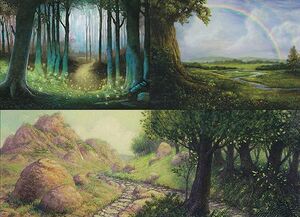Lorwyn–Shadowmoor: Difference between revisions
>Hunterofsalvation (→Lorwyn) |
>Hunterofsalvation (→Tribes) |
||
| Line 67: | Line 67: | ||
It is thought that faeries do not dream, which would explain why they spend so much time harvesting the dreams of others. Faeries can distill these stolen dreams into a sparkling energy that they carry around with them. Whether the faeries transport, store, or consume the dream-stuff for their own enjoyment is unknown, but at least one traveler has reported that the amount of dream-stuff harvested could represent a significant amount of magical power if collected over time. <ref name="Survival Guide"/> | It is thought that faeries do not dream, which would explain why they spend so much time harvesting the dreams of others. Faeries can distill these stolen dreams into a sparkling energy that they carry around with them. Whether the faeries transport, store, or consume the dream-stuff for their own enjoyment is unknown, but at least one traveler has reported that the amount of dream-stuff harvested could represent a significant amount of magical power if collected over time. <ref name="Survival Guide"/> | ||
===Tribes=== | ===Giants=== | ||
The [[giants]] are by far the strongest individual [[warriors]] on Lorwyn. Since giants require so much terrain to move around in, they can also be fiercely territorial. Note that giants tend to have one-track minds — when they are friendly, they are magnanimously friendly to all beings, but when they are angry, their rage shakes the earth for weeks. These giants are a race of hermits, arbiters, explorers, and oracles. Some huddle in mountain caves; you can spot a giant's lair by the enormous, rugged dolmen stones built up around the entrance. <ref>{{DailyRef|mtgcom/arcana/1463|Dolmens|[[Magic Arcana]]|November 15, 2007}}</ref> Others range over Lorwyn with long, loping steps. You can tell a giant's travel route by the man-sized, earth-compressed footprints and lack of vegetation. <ref name="Survival Guide"/> | |||
==Tribes=== | |||
* [[Shapeshifters#Changelings|Changelings]] | * [[Shapeshifters#Changelings|Changelings]] | ||
* [[Kithkin#Lorwyn Kithkin|Kithkin]] | * [[Kithkin#Lorwyn Kithkin|Kithkin]] | ||
* [[Merfolk#Merrows|Merrows]] | * [[Merfolk#Merrows|Merrows]] | ||
Revision as of 19:16, 7 November 2014
| Lorwyn–Shadowmoor | |
|---|---|
| Information | |
| First seen | 'Lorwyn' |
| Last seen | 'Eventide' |
| Status | Fused; otherwise unknown |
Lorwyn–Shadowmoor was a plane with two aspects. While Lorwyn represents day, Shadowmoor is night. Lorwyn switched to Shadowmoor cyclically every few centuries, an unnatural event triggered by the Great Aurora.
Lorwyn
Lorwyn is one of two aspects of the plane, and setting of the Lorwyn block.
The known portion of the plane is heavily forested and ringed by high mountains, outside of which lay the mysterious Primal Beyond. The world has no oceans or large lakes; all of its water comes from a system of rivers and streams connected by the subterranean Dark Meanders. Lorwyn is a world without winter and without night, locked in a perpetual late spring where the sun never quite dips below the horizon.
The indigenous wildlife of the Lorwyn is dominated by eight sentient races: elves, kithkin, merrows, flamekin, boggarts, treefolk, giants and faeries. Lorwyn is one of the few known places in the multiverse where humans are not occurring naturally. [1] [2] [3] In addition, Lorwyn supports a menagerie of animal and supernatural life, including wisents, springjacks, cervins, a semisentient race of mimics known as changelings and the majestic greater elementals. All of them thrive in Lorwyn's temperate environment and unending growing season, preserving the plane's character as an unspoiled natural wilderness. [1]
Each of the nine races (including the Changelings), known as the Tribes, live in an uneasy state of peace; skirmishes and small battles occur from time to time, but full-scale war is unknown. The Tribes are highly provincial and distrustful of those outside their race; all are wary of the cruel and powerful elves, who function as the plane's de facto rulers.
Lorwyn is a backwater world rarely visited by planeswalkers. Those who know of its existence regard it as an idyllic paradise. Late in Lorwyn's history, the barriers between the Tribes began to break down as individuals from different races came together in new tribes based on common goals (soldiers, wizards, and so on).
Boggarts

Lorwyn's race of goblins are called boggarts. Boggarts have greater diversity of morphology than other planes' races and sub-clans of goblins. Some of them have curving horns, others have stubby ones or none at all. Some of them have long snouts or goatlike muzzles. Some have broad, floppy ears; some have the sharp pointies. Their skin varies from green to blue to beige to purple to red. [4]
Boggarts are organized into warrens: Stinkdrinker warren, known for "its stockpile of stolen goods", and "its boggarts' penchant for sneaking past even giants to steal their prizes"; Squeaking Pie warren, known for "its culinary adventurousness — they bake mice and other delectables into their pies, and will go to any lengths to find bizarre new recipes and ingredients"; Mudbutton warren, "a particularly chaotic and loud warren that appreciates a good party — even if comes at the expense of a few of their members"; and Frogtosser warren, a "group of boggarts so emotionally changeable that the other warrens think them insane". [4]
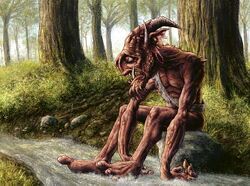
Boggart warrens are led by nominal leaders called Aunties. The Auntie is usually the oldest boggart in the warren, and is usually female (some are male, yet are still called "Auntie"). The Auntie knows many tales, like fables, that they tell to educate their warren, pass on crucial boggart teachings, and adjudicate disputes. The most famous Auntie fables are about Auntie Grub, a folk hero to the boggarts and probably a real ancestor. Auntie Grub's tales are particularly helpful for informing young boggarts about racial enemies, dangerous predators, poisonous plants and fungus, and the like. [4]
Boggarts are described as being "collectors of sensation", and that, "while they aren't particularly intelligent thinkers, they are extremely perceptive, in that they perceive a lot." [4] When it comes to arming themselves, they improvise what they can't steal. [5]
About the only law in boggart culture, in fact, is the pressure to share new sensations with others of their kind. A boggart that refuses to share — a hoarder — will be cast out of boggart society for the sin of keeping a new treasure to himself. Since boggarts are so social and convivial among their own, exile is considered a terrible sentence. [4] [6]
Elementals
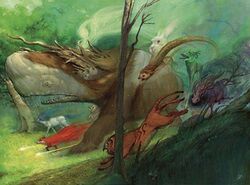
On Lorwyn, abstract entities such as hopes, fears, dreams, and nightmares are just as real as the grass and the trees. These Elementals only exist insofar as do the elements of which they're composed. They vary in prevalence just like the abstract idea underlying them. If [[elves] wage war on giantkind, then many-clawed elementals of warfare and strife can be seen with greater frequency. If merrows launch an expedition to the murky Deep Meanders of their river system, then soggy elementals of the sunken unknown appear. On the other hand, if bloodshed keeps to a minimum across the plane, elementals of violent death may themselves die out — at least, until their time comes again. [7]
Flamekin
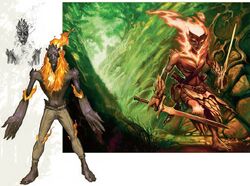
Flamekin are beings of fire and mutable stone whose strong, intense passions drive them to wander the world. The flame of their bodies burns magically cool, but they can choose to burn hot at will. Other races are wary of flamekin and their fickle, fiery natures, a reputation that a group of flamekin called the Brighthearth are working to change. The Brighthearth serve as emissaries of flamekin goodwill to other races, performing useful tasks that require fire, such as smithing. On the other hand, one named Vessifrus is an upstart looking to inspire rebellion among the flamekin. One day he may lead an uprising against the tyranny of the beauty-obsessed elves.
Flamekin have an almost spiritual connection to the more mysterious greater elementals of Lorwyn. Flamekin regard them as totems or demigods that inspire their creative impulses — or frustrate their understanding. [7]
Greater elementals
Greater Elementals are the living embodiments of the abstract mental ideas and concepts dreamed by the people, such as vigor, hostility, and guile. [8] Vastly different in form from other worlds' elementals, the greater elementals take the form of bizarre combinations of natural animals, many of colossal size. They are nonsentient beasts that pursue their own simple needs with little concern for Lorwyn's tribal conflicts.
Under normal circumstances, an elementals are forces of nature; nothing tames them. But of course, planeswalkers are a different story; with enough mana and effort, they can not only call on the essences of greater elementals, but also summon the elementals themselves, along with the power they bring. [7]
Elves
The elves of Lorwyn are aristocratic, ruthless, and predatory. Their society revolves around the laws of beauty, a code that specifies how one's cunning and personal attractiveness determine one's social rank. If you are only moderately beautiful, you are a low-ranking elf. If you are ugly or disfigured — or a non-elf, which is by definition a truly ugly thing to be — then you are an eyeblight, a creature unworthy of respect or even, if it is deemed so, life. There are four official ranks of elves, determined by measure of beauty — plus the non-rank of eyeblight for everyone else. [9]
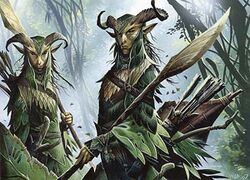
The four social classes are:
- Faultless
- Any elf who possesses the minimum threshold of beauty and grace is granted this basic rank.
- Immaculate
- Dignitaries, VIPs and higher-level functionaries among elves attain the rank of immaculate.
- Exquisite
- Packmasters (lords of elvish hunting packs) and important courtiers are of the exquisite rank. They have the privilege of being able to speak directly to perfects.
- Perfect
- The perfect are elves so beautiful and so shrewd that they rule all other elves. There are only a few of these in the world. Perfects can kill those of low rank with impunity (Note: This rank is "perfect" and not "prefect"). [10]
Lorwyn's elves are distinguished by their cultivation of a white flower called moonglove, from which can be derived a potent poison. This poison is deadly even in small amounts, taking down even towering giants. In precisely controlled, highly diluted trace amounts, its necrotizing properties can be used to etch or carve living tissue — such as skin or bark. Also, unlike the elves of other planes, Lorwyn's elves view nature as "something to be improved, cultivated, and if necessary, rearranged." [9]
Fae
No race on Lorwyn is more ubiquitous or mysterious than its faeries. The fae lead short, flitting lives in pursuit of gossip, diversions, and amusing intrigues. Petty and vain, faeries are like petulant children at play. They love to have fun, to revel in Lorwyn's eternal midsummer, and to follow their whims. But faeries can also be carelessly cruel, capricious, and vindictive. [11]
Faeries travel in small groups of three to six called cliques. Where faeries originate is unknown, but they claim to serve Oona, the enigmatic Queen of the Fae. Oona has never been seen, and is believed by many of the races of Lorwyn to be strictly mythical. [1]
It is thought that faeries do not dream, which would explain why they spend so much time harvesting the dreams of others. Faeries can distill these stolen dreams into a sparkling energy that they carry around with them. Whether the faeries transport, store, or consume the dream-stuff for their own enjoyment is unknown, but at least one traveler has reported that the amount of dream-stuff harvested could represent a significant amount of magical power if collected over time. [1]
Giants
The giants are by far the strongest individual warriors on Lorwyn. Since giants require so much terrain to move around in, they can also be fiercely territorial. Note that giants tend to have one-track minds — when they are friendly, they are magnanimously friendly to all beings, but when they are angry, their rage shakes the earth for weeks. These giants are a race of hermits, arbiters, explorers, and oracles. Some huddle in mountain caves; you can spot a giant's lair by the enormous, rugged dolmen stones built up around the entrance. [12] Others range over Lorwyn with long, loping steps. You can tell a giant's travel route by the man-sized, earth-compressed footprints and lack of vegetation. [1]
Tribes=
Locations
- Gilt Leaf Wood
- Glen Elendra
- Kithkin clachans:
- Mount Tanufel
- Murmuring Bosk
- Porringer Valley
- The Primal Beyond
- Velis Vel
- The Wanderwine
- The Dark Meanders
Shadowmoor
Shadowmoor, the setting of the Shadowmoor block, is the other facet of the plane.
The inhabitants of Lorwyn don't recall their previous lives, and remember having always lived in Shadowmoor. There are, however, a handful of beings who retain their memories; for example, in the storyline's latest Great Aurora: Ashling, Brigid Baeli, Maralen, Oona, the Vendilion Clique, Rosheen Meanderer, and The Sapling.
Another difference between the two planes is that some creatures who are nonexistent in Lorwyn are active in Shadowmoor, while others have been expunged from the new plane. Ouphes, korrigans, pucas, kelpies, scarecrows, and nightmarish, mythical beings that had slumbered beneath Lorwyn's surface have reemerged in the ambient night. What races have survived the change have been thoroughly altered by the tainted darkness covering Shadowmoor. In particular, the demeanor of each race has taken a turn for the worst. The kithkin have become withdrawn and distrusting of the other inhabitants of the plane and the boggarts are now violent brutes. The flamekin, now called cinders, have lost their passion and become hateful shadows of themselves; giants have lost their intelligence, and rely in their basic instincts; the merrows are spiteful pirates and raiders who lurk in their murky rivers; the treefolk are warped skeletons of bark and branches; and the playful changelings have become the malicious mimics.
The elves, in contrast, were one tribe to experience a more positive difference. They became the last remnant of Lorwyn's older, idyllic environment. Pressed upon by hostile conditions, the elves were forced to battle for their very existence. Rather than lording over the plane and oppressing the other species to conform to their values of beauty and grace, the ironic reversal in their situation shifted the elves from arrogance to humbled self-preservation.
The only race that remained mostly the same are the fae, because they are protected by Oona's magic, and thus have remained mischievous and unpredictable.
Lorwyn–Shadowmoor fused
At the end of the Eventide, the Great Aurora is no more, although the resulting plane's structure and races hasn't been disclosed yet.
Creatures of Shadowmoor
Humanoid races
Monsters
Locations
- The Dark Meanders
- Kithkin clachans
- Glen Elendra
- Mount Kulrath
- Velis Vel
- The Wanderbrine
- Wilt-Leaf Wood
References
- ↑ a b c d e Doug Beyer (October 31, 2007). "Lorwyn Survival Guide". magicthegathering.com. Wizards of the Coast.
- ↑ Magic Arcana (November 14, 2007). "Lorwyn Legend Art". magicthegathering.com. Wizards of the Coast.
- ↑ Jeremy Jarvis (September 17, 2007). "Lorwyn: The Human-Shaped Hole". magicthegathering.com. Wizards of the Coast.
- ↑ a b c d e Doug Beyer (October 3, 2007). "Bog is for Boggart". magicthegathering.com. Wizards of the Coast.
- ↑ Magic Arcana (November 29, 2007). "Boggart Weaponry". magicthegathering.com. Wizards of the Coast.
- ↑ Wizards of the Coast (October 29, 2007). "The Hoarder's Consequences". magicthegathering.com. Wizards of the Coast.
- ↑ a b c Doug Beyer (September 27, 2007). "Elementalism". magicthegathering.com. Wizards of the Coast.
- ↑ Magic Arcana (November 28, 2007). "Lorwyn Elemental Swaps". magicthegathering.com. Wizards of the Coast.
- ↑ a b Doug Beyer (September 13, 2007). "A Taste of Lorwyn". magicthegathering.com. Wizards of the Coast.
- ↑ Doug Beyer (October 24, 2007). "Ask Wizards — October, 2007". magicthegathering.com. Wizards of the Coast.
- ↑ Magic Arcana (October 02, 2007). "Faeries vs. Giants". magicthegathering.com. Wizards of the Coast.
- ↑ Magic Arcana (November 15, 2007). "Dolmens". magicthegathering.com. Wizards of the Coast.
